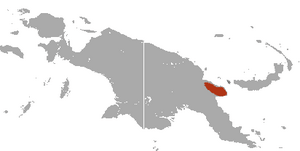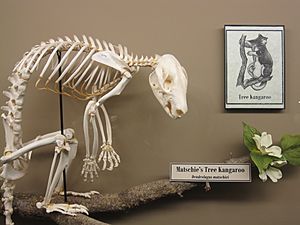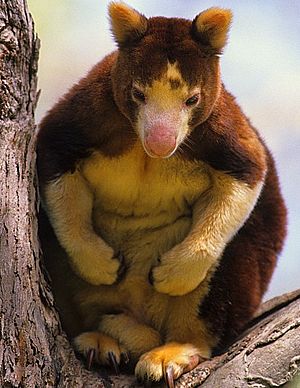Matschie's tree-kangaroo facts for kids
Quick facts for kids Matschie's tree-kangaroo |
|
|---|---|
 |
|
| At the Bronx Zoo, New York City | |
| Conservation status | |
| Scientific classification | |
| Genus: |
Dendrolagus
|
| Species: |
matschiei
|
 |
|
| Matschie's tree-kangaroo range | |
The Matschie's tree-kangaroo (Dendrolagus matschiei), also called the Huon tree-kangaroo, is a special type of tree-kangaroo. It lives in the Huon Peninsula in northeastern New Guinea island, which is part of Papua New Guinea.
This amazing animal is listed as an Endangered species by the IUCN. This means it is at high risk of disappearing forever. The scientific name for this tree-kangaroo honors a German biologist named Paul Matschie.
Contents
Physical Features of Matschie's Tree-Kangaroo
Matschie's tree-kangaroos are much smaller than the well-known red kangaroo from Australia. Their body and head can be about 50 to 81 cm long. An adult male usually weighs between 9 and 11 kg, while an adult female weighs between 7 and 9 kg.
These tree-kangaroos do not have a specific breeding season. A female is pregnant for about 44 days. Baby tree-kangaroos, called joeys, stay in their mother's pouch for about 11 months. We don't know how long they live in the wild, but they can live for at least 14 years. In zoos, they can live for about 20 years.
One unique thing about all tree-kangaroos is a special swirl of hair on their bodies. This hair patch grows in many directions. For Matschie's tree-kangaroo, this swirl can be anywhere from its shoulders down to its tail.
Their fur is golden on their belly, the lower parts of their legs, and the edges of their ears and tail. The rest of their body is a chestnut brown color. They often have a dark stripe down their back. Their faces are usually a mix of yellow and white. Matschie's tree-kangaroos look similar in color and size to the Doria's tree-kangaroo (Dendrolagus dorianus).
Matschie's tree-kangaroos have small, bear-like ears, which means they don't hear very well. They have curved claws on their front paws and soft pads on their back feet. These features help them climb trees easily. They can also move their fingers and bend their front limbs a lot, which gives them good grip.
Scientists have found that Matschie's tree-kangaroos can walk on two legs. Their limbs can rotate a lot, which is great for climbing. Among all tree-kangaroo species, the Matschie's is the best at climbing straight up. They also have stronger muscles than other tree-kangaroos. Their tails are about the same length as their head and body. This long tail helps them balance when they move quickly through trees.
Males and females are almost the same size. Their jaws are also different. The upper jaw has three incisors (front teeth), one canine, one premolar, and four molars. The lower jaw has one very sharp incisor, no canines, and molars that are not very tall.
Life in the Wild
Matschie's tree-kangaroos live in the mountainous rainforests of New Guinea. They are found at heights between 1,000 and 3,000 m above sea level. These kangaroos usually live alone or in very small groups. A group might be a female, her joey, and a male.
They spend most of their time in the trees. They only come down to the ground sometimes to find food. They are excellent at hopping and can leap up to 9 m!
Instead of sweating to cool down, Matschie's tree-kangaroos lick their forearms. The liquid then evaporates, which helps to cool their bodies.
In the wild, they mostly eat leaves, fruits, and mosses. In zoos, they eat a variety of foods like apples, carrots, yams, corn, celery, and leafy greens. They also eat special monkey biscuits, tofu, hard-boiled eggs, and branches from trees like elm and willow.
Researchers have found that most Matschie's tree-kangaroos in the wild live alone. Sometimes, they live in small groups, often with a mother, her baby, and one male. These groups usually have an equal number of males and females. Matschie's tree-kangaroos are very closely related to the Goodfellow's tree-kangaroo (Dendrolagus goodfellowi).
Matschies’ seem to be shy of humans. They quickly move away when people are nearby, making them hard to find in the forests. They spend about 14 to 15 hours a day sleeping and resting. Matschie's tree-kangaroos are known for protecting their home areas and marking their boundaries.
They can keep their body temperature steady even when the weather changes a lot. Matschies’ can get certain infections, but these infections don't seem to spread easily to other kangaroos. Scientists are still studying how these infections spread.
Where They Live

Matschie's tree-kangaroos are only found on the Huon Peninsula in Papua New Guinea. They are the only type of tree-kangaroo that lives there. They also live on Umboi Island, which is off the coast of Papua New Guinea. However, most scientists think they were brought to Umboi Island by humans and did not originally live there.
They prefer to live in forests where trees lose their leaves and in tropical rainforests. This is because they spend most of their time in trees. They mainly live in the northeast part of New Guinea. Their home area can be about 25 hectares in size.
What They Eat
Matschie's tree-kangaroos are mainly folivores, which means they eat leaves. They also eat sap, insects, flowers, and nuts. In captivity, they have been known to eat chickens, as well as various plants, carrots, lettuce, bananas, potatoes, hard-boiled eggs, and yams.
Since they eat foods high in fiber, they only need to eat for about 1 to 2 hours each day. The rest of the time, they are resting and digesting their food. Their digestion is similar to that of animals like cows. They have a large stomach where tough plant material is broken down.
Reproduction and Life Cycle
In zoos, Matschie's tree-kangaroos can have babies at any time of the year and breed well. A female's cycle is about 54 to 57 days long. Tree-kangaroos can start having babies when they are 2 to 2.5 years old.
Mating happens when a female approaches a male on the ground. They touch noses and make clicking sounds with their tongues. At first, the female might resist the male, hissing and swatting at him. But within ten minutes, she will allow him to mate. Mating can last up to an hour.
The pregnancy lasts about 44 days, which is one of the longest for any marsupial. One birth observed in a zoo happened high up in the branches. Joeys first poke their heads out of the pouch at about 22 weeks old. They start leaving the pouch and eating on their own at 28 weeks. Joeys leave the pouch for good around 41 weeks. If a joey is lost from the pouch, the mother can get pregnant again very quickly.
Protecting Matschie's Tree-Kangaroo
Threats to Their Survival
In 1996, the IUCN listed Matschie's tree-kangaroos as endangered. A big problem is that many trees in the Huon Peninsula, where they live, have been cut down. This creates more grassy areas and destroys their natural home. They are also threatened by oil drilling, logging, and hunting by people.
Some Matschie's tree-kangaroos are hunted by local people for their meat and fur. However, some villages, like Yawan in New Guinea, are helping to protect them. The people of Yawan have set aside 400 km² of land to help save the Matschie's tree-kangaroo.
Conservation Efforts
Many Matschie's tree-kangaroos do well in zoos and live healthy lives. In 1997, the number of Matschie's tree-kangaroos in North American zoos reached 90 animals. However, this number has gone down to 53 in recent years.
North America started the Tree Kangaroo Species Survival Plan (TK-SSP) in 1991 to help with their conservation. This plan helps manage the breeding of tree-kangaroos in zoos to keep their populations healthy. Education programs have also been set up in schools thanks to Lisa Dabek, an expert who has spent much of her life helping and studying these animals.
Dabek and other scientists have caught many Matschie's tree-kangaroos in the wild. They put radio collars on them to study their habits. Tracking them helps scientists learn about their home ranges and the types of places they live in. This information helps them protect those important areas.
Conservation International, an organization that works to protect Earth's living things, is part of the Tree Kangaroo Conservation Program. This program started in Papua New Guinea and is now based at the Woodland Park Zoo in Seattle, USA. It aims to study and protect different tree-kangaroo species.
The program also encourages local villages in Papua New Guinea to help with conservation. It supports local schools and teachers and improves medical care for the people. It also identifies special habitats that tree-kangaroos need to thrive. The Woodland Park Zoo is very dedicated to helping the Matschie's population grow. They have also found that mothers raise their young better if they are separated from males after mating.
Zoos around the world have created a Species Survival Plan to help save Matschie's tree-kangaroos. They want to stop the destruction of their natural homes and keep healthy populations growing in zoos. By keeping them in zoos, researchers hope to increase their numbers. They are very committed to this because Matschies’ are the most commonly seen tree-kangaroos in zoos worldwide. Scientists are still learning more about Matschie's tree-kangaroos and are doing studies to watch and help wild populations.
In 2009, the YUS Conservation Area was created to protect the Matschie's habitat in the northern part of the Huon Peninsula. YUS covers over 760 km² and includes three rivers: Yopno, Uruwa, and Som. The area was named after these rivers.
Scientists compare the genes of zoo-bred tree-kangaroos with those in the wild. This helps them see if the zoo breeding program is keeping the genetic variety of the population over time. One study found that zoo tree-kangaroos had less genetic variety than wild ones. This difference shows how changes can happen when animals are taken out of their natural homes.
- ARKive - images and videos of the Huon tree kangaroo (Dendrolagus matschiei)
- Tree Kangaroo Conservation Program - saving the tree kangaroos
See also
 In Spanish: Canguro arborícola de Huon para niños
In Spanish: Canguro arborícola de Huon para niños




